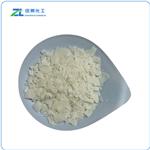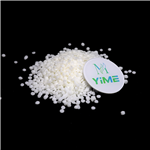Chemical Properties
Crude yellow beeswax is harvested together with honey and represents a secondary secretion of the bee. Once the
honey is recovered from the honeycomb by draining the cells, the wax combs are washed with water, melted and poured into molds
to harden. The wax is refined by melting in hot water to which sulfuric acid or alkali may be added to extract impurities. The resulting wax is referred to as yellow beeswax. Yellow beeswax contains cerolein, a mixture of fatty acids and soluble in hot alcohol and
slightly soluble in cold alcohol; myricyl alcohol and myricyl palmitate, insoluble in alcohol. Beeswax is produced worldwide with the
same chemical composition. The odor may vary slightly, depending on the source.
Chemical Properties
White wax consists of tasteless, white or slightly yellow-colored
sheets or fine granules with some translucence. Its odor is similar to
that of yellow wax but is less intense.
Chemical Properties
Beeswax absolute is obtained by alcohol extraction of beeswax. The yield
is generally less than 1%.The yellowish-brown, viscous product has a mild,
honey-like odor, and high tenacity; it is used almost exclusively in fine fragrances.
Chemical Properties
white to yellowish-white pieces or plates
Physical properties
It is a yellowish to grayish-brown solid, somewhat brittle when cold, and presents a dull granular, noncrystalline fracture when broken. It becomes pliable at about 35°C.
Occurrence
Wax from the honeycomb of the bee, Apis mellifera L.
Uses
Beeswax is used to produce edible films (sodium caseinate, soy protein isolate, etc.). It can form a mixture with a variety of fatty acids and polyols to provide flexibile, elastic and stretchable films. It also decreases the water vapor permeability and enhances the mechanical properties of the film.
Uses
Beeswax is used to produce edible films (sodium caseinate, soy protein isolate etc.). It can form a mixture with a variety of fatty acids and polyols to provide flexibile, elastic and stretchable films. It also decreases the water vapor permeability and enhances the mechanical properties of the film.
Definition
The wax obtained from the honeycomb of the bee. It consists primarily of myricyl palmitate, cerotic acid esters and some high-carbon paraffins.
Preparation
By alcoholic extraction of the raw wax(Fenarolfs Handbook of Flavor Ingredients,
1975).
Production Methods
Yellow wax (beeswax) is obtained from the honeycomb of the bee
(Apis mellifera Linne′ (Fam. Apidae)); see Wax, Yellow. Subsequent
treatment with oxidizing agents bleaches the wax to yield white
wax.
General Description
Beeswax is a natural wax that is formed from honeybee
Apis mellifera. It is a lipid that contains hydrocarbons, esters and free acids, which can be used to lower the transference of water on films.
Pharmaceutical Applications
White wax is a chemically bleached form of yellow wax and is used
in similar applications: for example, to increase the consistency of
creams and ointments, and to stabilize water-in-oil emulsions.
White wax is used to polish sugar-coated tablets and to adjust the
melting point of suppositories.
White wax is also used as a film coating in sustained-release
tablets. White beeswax microspheres may be used in oral dosage
forms to retard the absorption of an active ingredient from the
stomach, allowing the majority of absorption to occur in the
intestinal tract.Wax coatings can also be used to affect the release of
drug from ion-exchange resin beads.
Safety Profile
A mdd allergen.
Combustible when heated.
Safety
White wax is used in both topical and oral formulations, and is
generally regarded as an essentially nontoxic and nonirritant
material. However, although rare, hypersensitivity reactions to
beeswax (attributed to contaminants in the wax) have been
reported.
storage
When the wax is heated above 150℃, esterification occurs with a
consequent lowering of acid value and elevation of melting point.
White wax is stable when stored in a well-closed container,
protected from light.
Incompatibilities
Incompatible with oxidizing agents.
Regulatory Status
GRAS listed. Accepted for use as a food additive in Europe.
Included in the FDA Inactive Ingredients Database (oral capsules
and tablets; rectal, topical, and vaginal preparations). Included in
nonparenteral medicines licensed in the UK. Included in the
Canadian List of Acceptable Non-medicinal Ingredients.



